
Underground leaks within your irrigation system cannot be seen, so they can be difficult to find. However, above ground there will be obvious signs that something below ground is leaking or has broken, and should be taken care of immediately, before it causes serious damage to your entire irrigation system.
Here are 8 of the most obvious signs that anyone can spot with the naked eye that something is leaking or has broken beneath the ground surface.
- A gushing water spout would indicate a broken spray head or leak in the irrigation line. A leak in the irrigation line would cause a significant change in water pressure, causing the water to shoot up into the air.
- Flooded areas between sprinkler heads can be a sign of a slow and steady leak in a lateral line beneath the ground surface. Water spurting between sprinkler heads means a lateral line below ground has broken and has blown out the soil above it.
- Water trickling steadily out of an irrigation head long after the irrigation system has turned off could indicate a leaking- or weeping- valve below ground. The diaphragm seal may have worn out and water is seeping freely through 24/7. It could also mean the valve is clogged, preventing it from fully closing.
- Taller grass, or grass that is darker around a sprinkler head than the rest of the lawn could mean a pipe below ground is cracked or broken, and is over-saturating the area.
- A sprinkler that doesn’t spray as far as it used to, or is spraying dirty water would indicate a ruptured line below ground that is washing soil into your sprinkler line.
- Water dribbling over the curb can be a sign of over-irrigation or poor drainage. It could also mean you have a broken irrigation head.
- Slimy fungus forming on an adjacent curb could mean a slow irrigation leak, unless you are over-irrigating the area. Obviously, slow leaks will turn into big problems if not repaired.
- A fan-shaped alluvial sediment deposit on the sidewalk is caused by water transported soil, and could be a sign of a broken irrigation head.
Any one of these 8 signs is a strong indication that something within your irrigation system needs immediate attention and your landscape may be in jeopardy. Once you’re aware, the next step would be to find out what is actually cracked or broken below ground that the eye cannot see. Here’s where using a flow controller like FlowStation, or a water use analytics and leak detection service like WaterCompass Enterprise, can help you quickly identify leaks, protect property assets, and minimize risk.
When water flow drops below a certain threshold in the main line, it means something is leaking or has broken. Using smart irrigation gives you the ability to monitor for high and unexpected flow events by receiving alerts. Alerts will help identify possible causes, such as clogged heads and will also include possible remedies to repair any valve or pump issues, and proper supply pressure.

